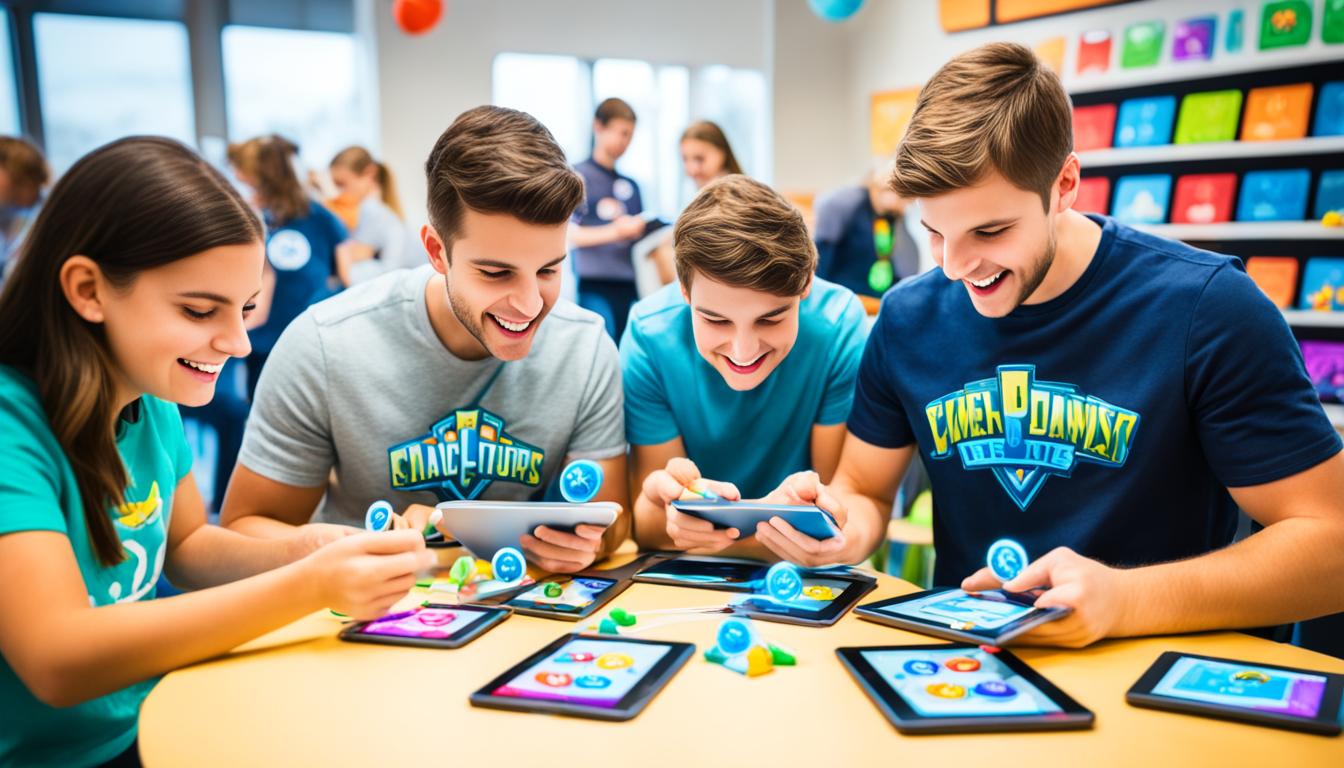Did you know that incorporating gamification in education can boost student engagement, motivation, and collaboration? Gamification is not just about playing games but integrating game design elements into the learning experience to make it more interactive and dynamic. By using gamification strategies, teachers can create a fun and stimulating environment that enhances learning outcomes.
Key Takeaways:
- Gamification in education can improve student engagement, motivation, and collaboration.
- By using gamification strategies, teachers can create dynamic and interactive learning experiences.
- Gamified learning promotes problem-solving and critical thinking skills.
- There are various gamification tools and platforms available for educators to implement in the classroom.
- Gamification in education is an effective strategy for promoting student engagement and participation.
Benefits of Gamification in Education
Gamification in education offers numerous benefits that can significantly enhance the learning experience for students. By incorporating game design elements and strategies, educators can create a more engaging and interactive learning environment. Here are some key advantages of gamification in education:
- Enhanced Student Engagement: Gamified learning experiences capture student attention and promote active participation. By integrating elements like challenges, levels, and rewards, students become fully immersed in the learning process and are motivated to achieve their goals.
- Promotes Student Motivation: Gamification strategies for students provide tangible rewards and recognition for their achievements and progress. This intrinsic motivation encourages students to invest time and effort into their learning, leading to improved outcomes and a sense of accomplishment.
- Fosters Collaboration and Teamwork: Gamified learning experiences often involve multiplayer games and group challenges, fostering collaboration and teamwork among students. Through interactive tasks and cooperative problem-solving, students learn to work together effectively and communicate their ideas.
- Develops Problem-Solving and Critical Thinking Skills: Gamification in education presents students with complex tasks and scenarios that require them to think critically, make decisions, and find creative solutions. By engaging in these activities, students develop essential problem-solving and critical thinking skills.
Overall, gamification in education offers a dynamic and interactive approach to learning that can have a profound impact on student engagement, motivation, collaboration, and the development of essential skills.
“Gamification in education offers a dynamic and interactive approach to learning that can have a profound impact on student engagement, motivation, collaboration, and the development of essential skills.”
With gamified learning experiences, students are no longer passive recipients of information but active participants in their own education. The gamification strategies for students create a supportive and challenging environment that encourages their growth and development.
To illustrate the benefits of gamification in education, consider the following table highlighting the key advantages:
| Benefits of Gamification in Education | Description |
|---|---|
| Enhanced Student Engagement | Gamified learning experiences capture student attention and promote active participation. |
| Promotes Student Motivation | Gamification strategies provide tangible rewards and recognition, motivating students to invest time and effort into their learning. |
| Fosters Collaboration and Teamwork | Gamified learning experiences involve multiplayer games and group challenges, fostering collaboration and teamwork among students. |
| Develops Problem-Solving and Critical Thinking Skills | Gamification in education presents complex tasks that require students to think critically, make decisions, and find creative solutions. |
These benefits underscore the importance of gamification in education. By leveraging gamification strategies for students, educators can create a more interactive and effective learning environment that prepares students for success.
Gamification Tools for Teachers
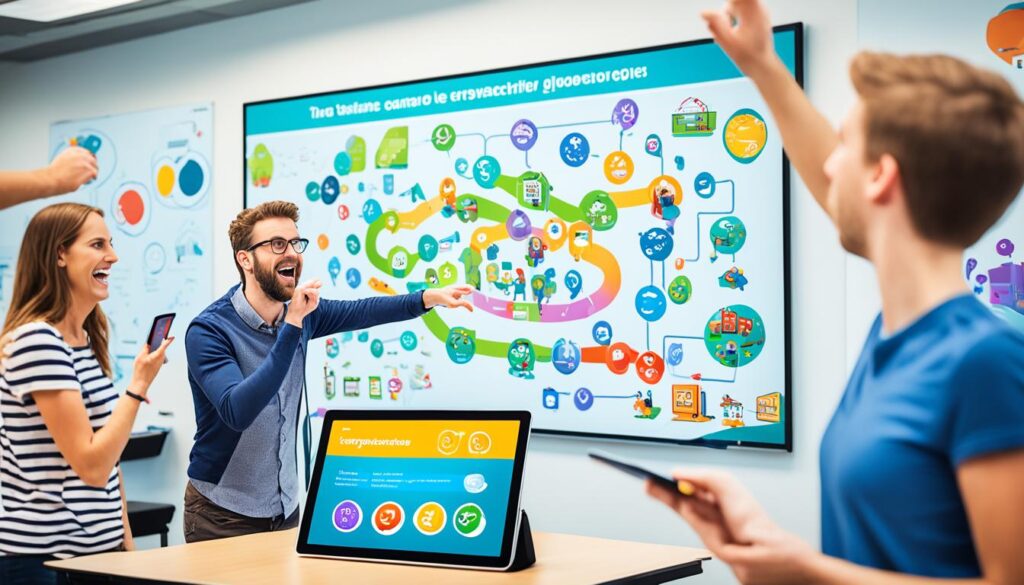
As an educator, incorporating gamification in the classroom can greatly enhance student engagement and learning outcomes. Luckily, there are several gamification tools available specifically designed for teachers to create interactive and dynamic learning experiences. These tools allow you to assess student knowledge, encourage participation, and track progress. Here are some popular gamification tools that you can explore:
Kahoot!
Kahoot! is a widely used gamification platform that enables you to create interactive quizzes, discussions, and surveys. You can easily customize questions, add multimedia content, and challenge students to compete against each other in real-time. With Kahoot!, learning becomes a fun and exciting experience.
Quizizz
Quizizz is a game-based learning platform that turns assessments into engaging quizzes. It offers a vast library of pre-made quizzes on various subjects, or you can create your own. Quizizz allows students to answer questions at their own pace, with built-in gamification elements like leaderboards and avatars.
Quizlet Live
Quizlet Live is a collaborative learning game that encourages teamwork and communication. Simply create flashcards on Quizlet and enable the Live mode, where students work in teams to match terms with their corresponding definitions. This tool promotes active learning and helps students retain information effectively.
Gimkit
Gimkit is a gamification tool that allows you to create interactive quizzes with customizable rewards. Students earn virtual cash for answering questions correctly, which they can use to purchase upgrades and power-ups. Gimkit keeps students motivated, engaged, and eager to improve their performance.
Besides using these gamification platforms, you can also adapt traditional games such as scavenger hunts and bingo to create educational experiences. Additionally, tools like Classcraft and Classbadges enable you to reward students with badges, track their progress, and create a sense of accomplishment and pride in their achievements.
Now that you’re familiar with these gamification tools for teachers, you can explore the possibilities they offer to make your classroom more engaging and interactive. By incorporating gamification strategies into your teaching, you’ll create a stimulating environment that promotes active learning and helps students thrive.
Creating Gamified Learning Experiences
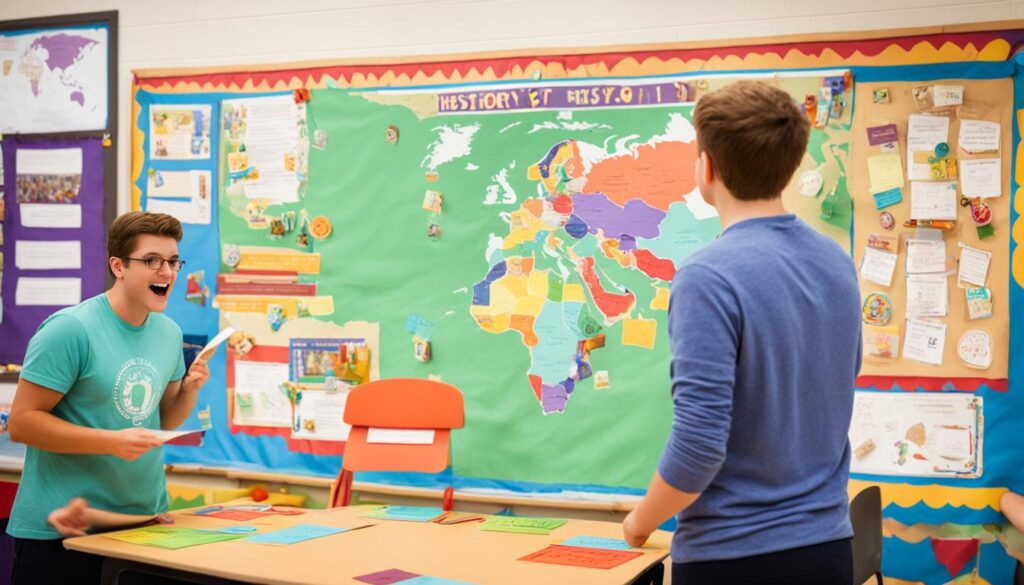
To create engaging and interactive learning experiences, educators can incorporate gamification techniques into their lessons. By leveraging game design elements such as leaderboards, achievements, and progress tracking, educators can enhance student motivation and engagement. The benefits of gamified learning go beyond just increased student participation; it also allows for personalized education that caters to individual student needs and abilities.
Gamification techniques provide clear objectives and rewards for students to accomplish, creating a sense of purpose and achievement. When students have clear goals to work towards and receive recognition for their accomplishments, they are more likely to stay motivated and engaged throughout the learning process.
With the use of adaptive technologies, gamified learning experiences can be tailored to the specific needs and abilities of each student. These technologies can adjust the difficulty level of the content, provide additional support for struggling students, or offer advanced challenges to keep high-achievers challenged. By adapting the learning experience to match each student’s capabilities, educators can foster a more inclusive and effective learning environment.
Benefits of Gamification in Schools
Gamification in schools offers numerous benefits for both students and educators. Here are some key advantages:
- Increased engagement: Gamification makes learning fun and exciting, capturing students’ attention and keeping them actively involved in the material.
- Enhanced motivation: By incorporating game elements such as rewards and achievements, gamification helps to motivate students to excel and achieve their goals.
- Improvement in learning outcomes: Through active participation and personalized experiences, gamified learning has been shown to improve students’ retention and comprehension of the material.
- Collaboration and teamwork: Many gamified learning experiences involve collaboration and teamwork, fostering important social and communication skills among students.
- Development of critical thinking and problem-solving skills: Gamification often presents students with challenging tasks, requiring them to think critically and solve problems in creative ways.
By incorporating gamification techniques into their lessons, educators can create a dynamic and immersive learning environment that promotes student engagement and academic success.
Education is not the filling of a pail, but the lighting of a fire.
– William Butler Yeats
Promoting Student Engagement Through Gamification
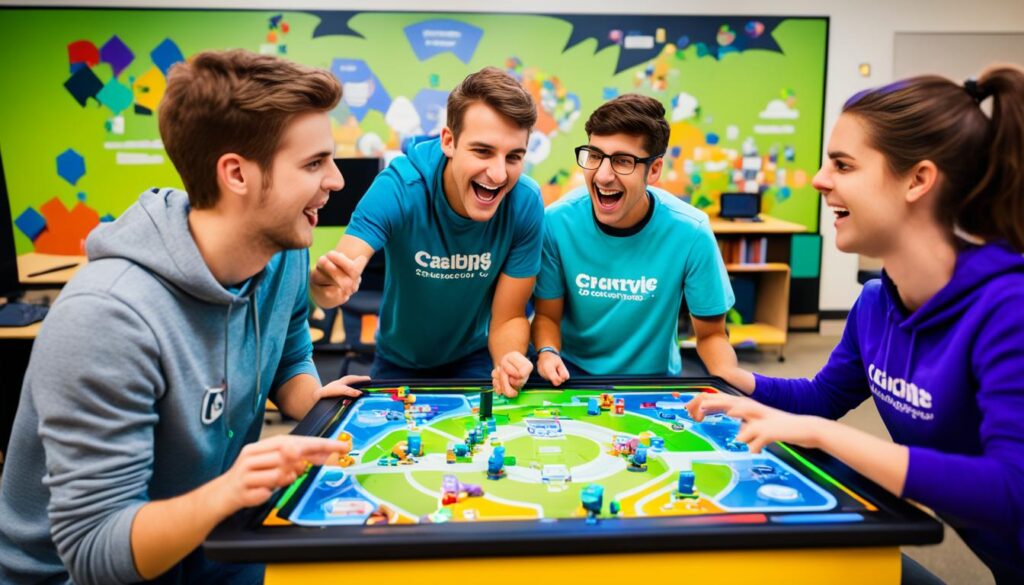
Gamification in education is an effective strategy for promoting student engagement. By incorporating game design elements into the learning process, educators can make it more fun and interactive, encouraging students to actively participate and immerse themselves in the subject matter.
One of the key advantages of gamification is that it creates a sense of adventure and challenge for students. Quests and boss battles, for example, provide students with exciting tasks and obstacles to overcome, motivating them to complete their assignments and strive for excellence.
“Gamification in education creates a sense of adventure and challenge, motivating students to complete tasks and overcome obstacles.”
This approach to learning is particularly effective in online and e-learning environments where gamification strategies can compensate for the lack of face-to-face interaction. Through gamified activities and experiences, students can connect with the subject matter in a dynamic and interactive way, fostering a deeper understanding of the content.
To further illustrate the impact of gamification in promoting student engagement, consider the following example:
| Traditional Learning | Gamified Learning |
|---|---|
| Passive consumption of information | Active participation and hands-on learning |
| Fixed curriculum with limited flexibility | Personalized learning experiences and adaptive content |
| Low motivation and disengagement | Increased motivation and enthusiasm |
| Individual progress tracking is limited | Real-time feedback and progress tracking |
As seen in the table above, gamified learning experiences provide a more dynamic and engaging learning environment, fostering active participation, personalization, and motivation among students.
Whether it’s in a traditional classroom or an online learning setting, gamification is a powerful tool that can transform the educational experience and empower students to take ownership of their learning journeys.
Gamification Platforms for Educational Purposes
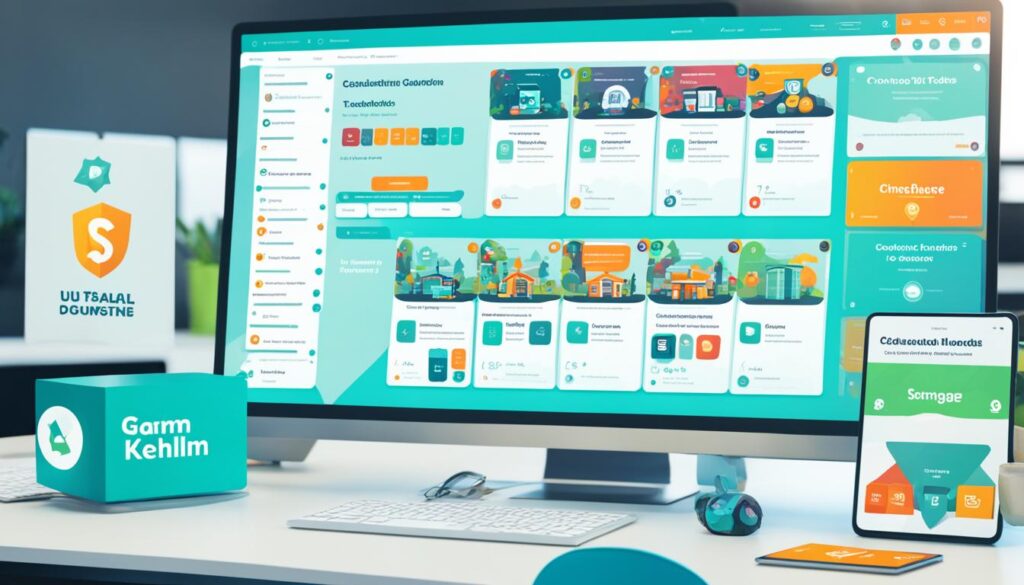
When it comes to incorporating gamification in education, there are a variety of platforms available for teachers to utilize. These platforms offer unique features and tools that enable educators to create engaging and interactive learning experiences for their students. Let’s explore some of the popular gamification platforms:
1. Classcraft
Classcraft is a widely-used platform that allows teachers to gamify their classrooms by incorporating game mechanics, such as quests and boss battles, into their lessons. With Classcraft, teachers can create their own content-specific challenges and questions to keep students motivated and eager to learn. This platform also provides customizable avatars and rewards systems, enhancing the overall gamified experience.
2. Google Forms and Google Slides
While Google Forms and Google Slides are traditionally seen as productivity tools, they can also be utilized for gamification purposes. Teachers can create unique fictional bosses and interactive activities using these platforms. For example, they can design quizzes or interactive presentations that require students to tackle challenges and earn points for their progress. Google Forms and Google Slides offer a user-friendly interface and wide accessibility, making them ideal for implementing gamification techniques in the classroom.
Here’s an image showcasing the use of gamification platforms for educational purposes:
By leveraging these gamification platforms, educators can effectively engage their students in the learning process and make it more enjoyable. The use of game elements and interactive features has proven to be successful in motivating students and enhancing their overall educational experience.
Incorporating Gamification in the Curriculum
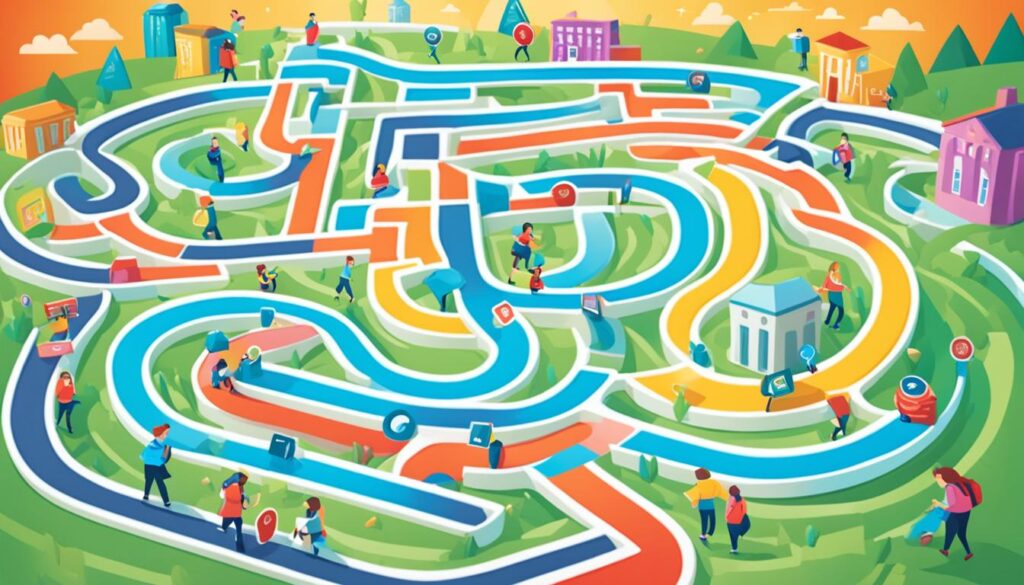
Start earning effortlessly! Claim your $3 bonus and monetize your unused data with Honeygain. It’s simple, secure, and smart.
Claim Nowand watch your balance grow! 🍯💸
Educators play a crucial role in shaping the learning experience for students. By incorporating gamification in the curriculum, teachers can create a more interactive and dynamic learning environment. Gamification involves leveraging game design elements to engage and motivate students, fostering their overall learning journey. Let’s explore some strategies that teachers can use to incorporate gamification effectively.
Align Game-Based Activities with Learning Objectives
When incorporating gamification, it’s essential to align game-based activities with learning objectives. This ensures that the games not only create an engaging experience for students but also contribute to their educational development. Teachers can design quests, challenges, and assessments that encourage active participation and critical thinking, while also addressing the core concepts and skills outlined in the curriculum.
Integrate Gamification Across Various Subjects
Gamification is a versatile approach that can be integrated across various subjects, such as math, science, language arts, and social studies. By using gamification techniques tailored to each subject, teachers can create immersive learning experiences that capture students’ attention and make complex topics more accessible. For example, in a math class, teachers can design a virtual treasure hunt to reinforce problem-solving skills and mathematical concepts.
Provide Opportunities for Collaboration
Gamification can also be used effectively to promote collaboration among students. Teachers can design multiplayer games and group challenges that require students to work together, fostering teamwork and improving interpersonal skills. By creating a collaborative learning environment, gamification can enhance social interactions and facilitate the exchange of ideas and knowledge.
Offer Personalized Learning Experiences
One of the significant advantages of gamification in the curriculum is its ability to provide personalized learning experiences. Adaptive technologies can assess students’ progress and tailor the content based on their individual needs and abilities. By adapting challenges and levels according to each student’s proficiency, gamification ensures a customized learning path that maximizes engagement and learning outcomes.
“Gamification in the curriculum not only engages students but also empowers teachers to design personalized and interactive learning experiences.” – Jennifer Thompson, Education Specialist
| Benefits of Incorporating Gamification in the Curriculum | Examples |
|---|---|
| Enhanced student engagement and motivation | Quest-based learning in history class, where students embark on virtual journeys to explore historical events |
| Improved critical thinking and problem-solving skills | A math game that challenges students to solve real-world problems using mathematical concepts |
| Promotion of collaboration and teamwork | A science project that requires students to work in groups to design and build a functioning model |
| Personalized learning experiences | An adaptive language arts game that adjusts difficulty levels based on students’ performance and progress |
By incorporating gamification in the curriculum, teachers can create a stimulating and immersive learning environment that captivates students’ attention and enhances their educational journey. It empowers students to take an active role in their learning, fostering a love for learning that extends beyond the classroom.
Gamification Impact on Student Engagement

When it comes to student engagement, gamification has a significant impact. Numerous studies have demonstrated that incorporating gamified learning experiences leads to increased motivation, participation, and overall achievement. But what makes gamification particularly effective in online learning settings?
Online learning can sometimes feel isolating, lacking the social interaction and sense of community that traditional classrooms offer. However, by implementing gamification strategies, educators can bridge this gap and create a more interactive and engaging virtual learning environment.
Gamification in online learning encourages collaboration and fosters a sense of community among students. Multiplayer games and group challenges allow students to connect with their peers, work together towards a common goal, and engage in healthy competition. This social interaction not only enhances their learning experience but also motivates them to actively participate in the online classroom.
Implementing gamification best practices is crucial to maximize student engagement in online learning. By providing clear goals and meaningful rewards, educators can create a sense of purpose and accomplishment for students. This not only promotes involvement in the learning process but also improves retention and knowledge retention.
To further illustrate the impact of gamification on student engagement, let’s take a look at the following table:
| Gamification Element | Impact on Student Engagement |
|---|---|
| Leaderboards | Encourages healthy competition and motivates students to strive for the top position. |
| Achievements and Badges | Rewards students for their accomplishments, boosting their self-esteem and motivating them to continue progressing. |
| Progress Tracking | Allows students to monitor their own progress, providing a sense of autonomy and control over their learning journey. |
| Quests and Challenges | Creates a sense of adventure and excitement, making the learning experience more enjoyable and engaging. |
The table above highlights the positive impact of various gamification elements on student engagement. By incorporating these elements into online learning experiences, educators can captivate students’ attention, stimulate their curiosity, and promote active participation.
Rather than solely relying on traditional teaching methods, incorporating gamification into online learning environments and following best practices is a proven strategy for enhancing student engagement and achieving positive learning outcomes.
Gamification Trends in Education
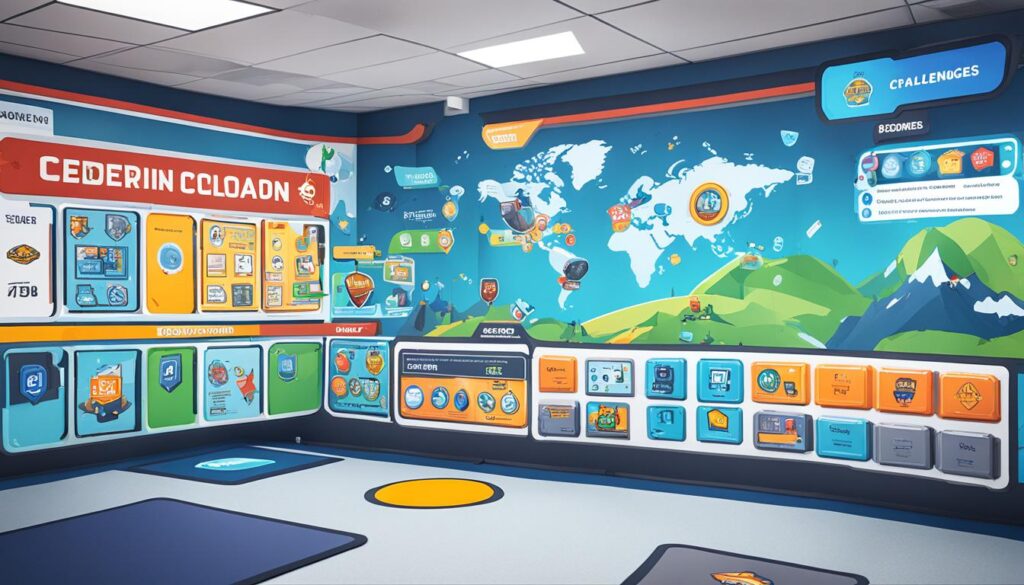
Gamification in education is a rapidly evolving field, with new trends and applications emerging. Educators are continuously exploring innovative ways to leverage gamification to enhance student engagement and learning outcomes. Let’s take a look at some of the latest gamification trends and how they are being applied in educational settings.
1. Gamification Platforms and Tools
Gamification platforms and tools are constantly evolving, offering educators a wide range of options to create gamified learning experiences. These platforms provide interactive features, such as leaderboards, badges, and rewards, that motivate students to actively participate and progress in their learning journey. Some popular gamification tools for students include:
- Kahoot! – a game-based learning platform that allows teachers to create interactive quizzes and competitions.
- Quizizz – a tool for creating engaging quizzes and assessments with a competitive element.
- Classcraft – an immersive platform that gamifies the classroom experience, fostering teamwork and collaboration.
By incorporating these gamification tools into their teaching practices, educators can transform traditional lessons into fun and engaging activities that promote active learning.
2. Digital Badges and Virtual Rewards
Digital badges and virtual rewards have gained popularity as a means of recognizing student achievements and progress. These virtual accolades provide a sense of accomplishment and motivation for students to continue their learning journey. Educators can award badges for completing tasks, reaching milestones, or demonstrating specific skills. The use of digital badges and virtual rewards not only boosts student engagement but also encourages healthy competition among peers.
3. Integration with Personalized Learning Platforms
Personalized learning platforms have become an integral part of modern education. These platforms utilize technology to tailor learning experiences to individual student needs, allowing for more personalized instruction. A growing trend is the integration of gamification with personalized learning platforms. By combining the benefits of both approaches, educators can create adaptive and engaging learning experiences that cater to each student’s unique learning style and pace.
4. Gamification for Skill Development
Gamification is also being used to enhance skill development in various subjects. For example, in mathematics, educators are incorporating gamified elements such as virtual math competitions or game-based problem-solving activities to strengthen students’ mathematical abilities. Similarly, in language arts, gamification can be applied through interactive storytelling or language-based quests, promoting literacy skills while keeping students engaged and motivated.
| Benefits of Gamification Trends in Education | Examples |
|---|---|
| Enhanced student engagement | Interactive quizzes, educational games |
| Improved motivation and persistence | Digital badges, virtual rewards |
| Customized learning experiences | Personalized learning platforms |
| Developing critical thinking and problem-solving skills | Subject-specific gamified activities |
Gamification trends in education are revolutionizing the way students learn by making education more interactive, enjoyable, and effective. By embracing these trends and leveraging the power of gamification tools and techniques, educators can create engaging learning environments that foster a love for learning and drive academic success.
Conclusion
Gamification in education has revolutionized the way students learn and engage in the classroom. By incorporating game design elements, educators can create interactive and dynamic learning environments that promote student motivation, collaboration, problem-solving, and critical thinking skills.
The advancements in educational technology and digital tools have opened up endless possibilities for incorporating gamification in education. From interactive quizzes and games to personalized learning platforms, the integration of digital tools has made gamification even more accessible and effective.
As educators continue to explore and implement gamification strategies, the benefits for student learning and success are bound to increase. By leveraging educational technology and utilizing digital tools, classrooms can be transformed into exciting spaces that foster creativity, curiosity, and a love for learning.
So why wait? Embrace the power of gamification in education and unleash the potential of your students!

